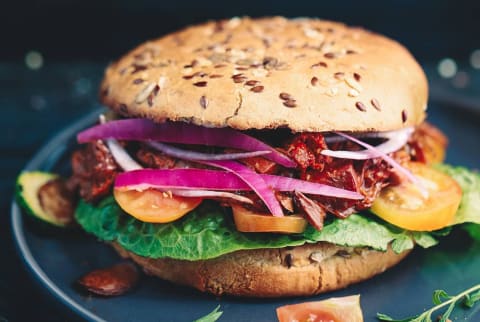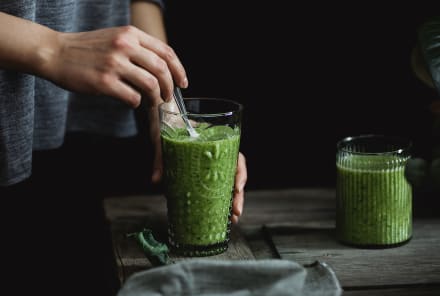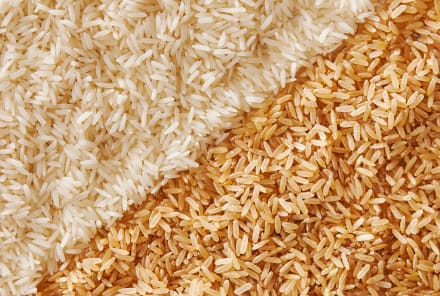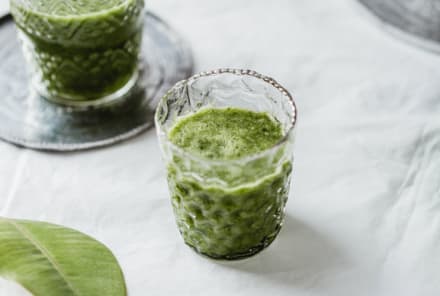Advertisement

You might have noticed jackfruit popping up more and more on your Instagram feed lately—popping up in tacos, BBQ sandwiches, and curries. If you're anything like me, you might've also been thinking: Why is a fruit being used in so many traditionally savory, meat-based recipes? Let me better acquaint you with this fruit and meat replacement. As a dietitian who loves everything about fresh fruit and vegetables (really—I just wrote an entire vegetable cookbook, The Essential Vegetable Cookbook), I have found that jackfruit is a huge game-changer for me. Read on to learn what exactly this nutrient-dense fruit is and how you can start to use it in recipes ASAP.
What is jackfruit?
Jackfruit is a big oval-shaped tree fruit with a hard and almost spiky outer green shell. Inside, the interior contains small fleshy pods that surround large seeds. Jackfruit has gained popularity over the past few years due to its extreme versatility—it has a unique texture and, depending on ripeness, can be used in both sweet and savory recipes.
This fruit is part of the Moraceae family, along with figs and mulberries. It's the largest existing tree fruit—weighing up to 100 pounds! Smaller jackfruit are still pretty big, weighing around 15 pounds; most fruit that you'll find in stores will weigh between 15 and 25 pounds (so make sure to bring a sturdy bag when grocery shopping!).
Where to buy jackfruit.
While it's indigenous to India and has been long grown all over Southeast Asia, jackfruit can now be found in the United States in a variety of forms. Because it grows in tropical weather, in the United States, jackfruit can mostly be found in states with tropical climates (like Florida). When shopping, you can find jackfruit in its whole-fruit, ripe state at places like Whole Foods Market or at many Asian markets. It will usually be near other tropical fruit, like mango or pineapple. You can also find it more widely distributed in the refrigerated prepared foods section or canned in its unripe form at places like Whole Foods Market and Trader Joe's.
What jackfruit tastes like.
Jackfruit is an extremely versatile fruit, with two completely different taste profiles depending on its ripeness. When ripe, the inside pods become a more orange-yellow color and take on a sweet taste, similar to mango, peach, or pineapple. It's a sticky fruit with a sweet, tropical smell.
The unripe form of jackfruit is still green inside and can be used in savory dishes. It has an almost bland and neutral taste, similar to a potato or an artichoke. Unripe jackfruit also has a sponge-like quality that enables it to easily absorb the flavors of different sauces and spices (much like tofu). Its texture is similar to pulled chicken or pork; because of this, unripe jackfruit is often used as a meat substitute.
To tell if jackfruit is ripe or not, look at the outside color. Green jackfruit is typically unripe—let it ripen at room temperature. When it's ripe, the outside of the fruit will turn a yellowish-brown color.
How to prepare jackfruit.
Probably the biggest mystery about the jackfruit is how to prep it—it's pretty big and can definitely look intimidating! Here's how to cut a jackfruit to get to the inside, edible flesh and seeds:
Start by cutting the fruit in half lengthwise. Because it's a pretty sticky fruit, it can be helpful to (carefully!) rub a little coconut oil over the knife to make cutting easier. Once the fruit is cut in half, start by removing the large seeds with your hands. These seeds are edible—so cook them immediately, or reserve them for later (see below for how to cook the seeds).
From there, cut the jackfruit in half again lengthwise so that it's quartered. Remove the inner core using your knife. The core holds the flesh together, so once it's removed, it should be pretty easy to get out the edible flesh. You can bend the skin backward like a mango to remove and pull apart the inner flesh, or cut the flesh out using a knife. The riper the jackfruit is, the easier this will be.
After that, you can prepare the jackfruit however you like—you can eat ripe jackfruit raw, cook unripe jackfruit, or freeze any extra to use later. A 15-pound jackfruit will yield about 16 cups of flesh (!) and 6 cups of seeds.
To easily cook jackfruit seeds, try roasting them at 400°F for about 20 minutes. Once roasted, remove the white outer shell and simply eat as is. Jackfruit seeds have a similar taste and feel to chestnuts.
If you don't want to try cutting jackfruit and prefer to buy it already prepped, simply look for options that are canned in brine as opposed to ones canned in syrup or other sweeteners. (As a bonus, Trader Joe's jackfruit canned in brine has a great amount of fiber per cup—7 grams!).
What are jackfruit's nutritional benefits?
Not only is jackfruit incredibly versatile, but it's also a nutritional powerhouse, loaded with different essential micronutrients. Compared to other fruit alone, jackfruit has about 3 grams of protein per cup—significantly more than most fruit contains. Although it has less protein than other meat substitutes, like tofu or tempeh, it's also a much less processed vegetarian protein option.
In one cup of the flesh, jackfruit has good amounts of potassium, vitamin B6, vitamin C, and magnesium. For vegetarians and vegans, jackfruit makes an excellent meat substitute as it contains around 25 percent of the daily recommended value for vitamin B6—a vitamin often hard to get in a vegetarian diet. This one cup of jackfruit contains nearly half of our daily needs for immune-boosting vitamin C and over 700 micrograms of potassium, a crucial electrolyte. Other notable nutrients in jackfruit include over 40 micrograms of stress-reducing magnesium and over 350 micrograms of calcium.
Want to try jackfruit for yourself?
If you're ready to try cutting it, look for whole jackfruit in any of the markets mentioned above. Or, to save time, look for canned or refrigerated pre-prepared jackfruit at many grocery stores. In sweet dishes, try ripe jackfruit as part of dessert or to add natural sweetness to a tropical smoothie. In savory recipes, jackfruit tacos are perfect for a flavorful, meatless meal—just add your favorite sauce.
Watch Next
Enjoy some of our favorite clips from classes
Enjoy some of our favorite clips from classes
What Is Meditation?
Mindfulness/Spirituality | Light Watkins
Box Breathing
Mindfulness/Spirituality | Gwen Dittmar
What Breathwork Can Address
Mindfulness/Spirituality | Gwen Dittmar
The 8 Limbs of Yoga - What is Asana?
Yoga | Caley Alyssa
Two Standing Postures to Open Up Tight Hips
Yoga | Caley Alyssa
How Plants Can Optimize Athletic Performance
Nutrition | Rich Roll
What to Eat Before a Workout
Nutrition | Rich Roll
How Ayurveda Helps Us Navigate Modern Life
Nutrition | Sahara Rose
Messages About Love & Relationships
Love & Relationships | Esther Perel
Love Languages
Love & Relationships | Esther Perel












